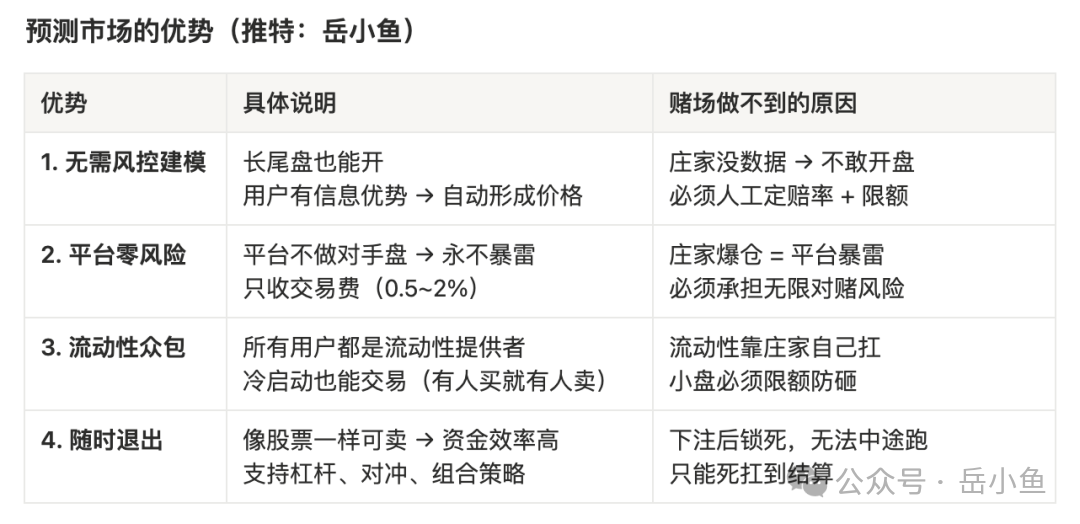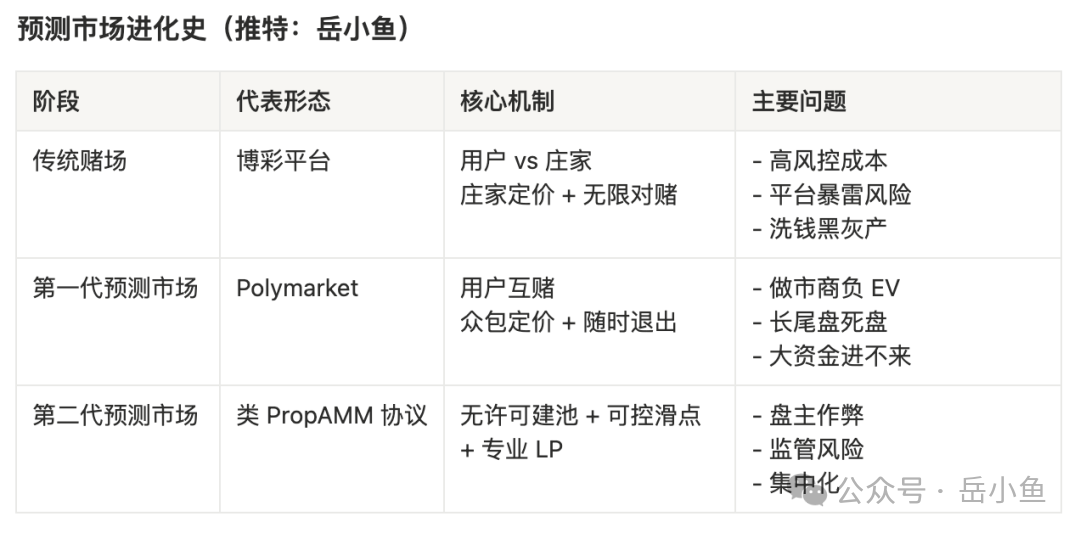Author: Yue Xiaoyu
How should we understand prediction markets?
Some say it's just a casino, while others claim it's a great innovation in information trading.
So what exactly are prediction markets?
The term "casino" carries too many negative and ambiguous connotations.
Calculating probabilities, guessing price movements, and placing bets, prediction markets may operate and feel like a casino, but to view them merely as a casino is more akin to lazy thinking and disdain for new concepts.
After systematic research, I believe prediction markets are not just casinos, nor merely a transformation of casinos, but rather an "information trading market" that can genuinely impact the world and aggregate market information.
We can systematically study prediction markets from the perspective of a casino.
1. What is the core difference between prediction markets and casinos?
The core difference between prediction markets and casinos lies in the fundamental distinction of pricing power and risk bearers.
In a casino: the central house sets prices + unlimited betting,
In a prediction market: users collectively set prices + bet against each other.
Here’s a comparison in table format:

Two examples can help illustrate the differences more clearly:
Casino example: Bet on "Brazil winning the World Cup"
You bet 100 yuan, odds 1.95
The house sets the price, you can only accept
If Brazil wins → you receive 195, the house loses 95
If Brazil loses → the house takes 100
The house is your only opponent, bearing all the risk
The house profits long-term through house edge (5%)
Prediction market example: Bet on "Trump winning the 2028 US election"
Current Yes = $0.60 (market price)
You buy 100 shares of Yes → spend 60 USDC
Someone sells you Yes → they believe Trump will not win
You and the "seller of Yes" are betting against each other
The platform (Polymarket) does not participate in the betting, only charges a 1% transaction fee
Prices are pushed by all buyers and sellers, like stocks
In simple terms, in a casino, you play cards against the house; in a prediction market, you play cards with friends.
2. What are the advantages of prediction markets over casinos?
The shift from betting against the house to users betting against each other brings many changes.
Prediction markets have four significant structural advantages over traditional casinos:

1. No need for complex risk control modeling
Under the mechanism of prediction markets, even very niche long-tail bets can be successfully established.
Events like "Will it rain tomorrow in a specific city?" can also be traded.
This is because users often possess information advantages, allowing reasonable prices to form automatically through market supply and demand.
In contrast, traditional casinos lack sufficient data support, making them hesitant to open such bets.
Traditional casinos must rely on manual setting of odds and implement strict limit measures.
2. Platform operators bear zero risk
Prediction market platforms do not act as counterparty to bets → thus, there will never be a situation of catastrophic failure.
The platform only needs to charge a low transaction fee (usually between 0.5% and 2%) to achieve profitability.
However, in traditional casino models, if the house goes bust = the entire platform faces a crisis.
This is because the house must bear all the immense risks associated with unlimited betting.
3. Liquidity sourced through a crowdsourcing model
In prediction markets, all participating users on the platform are effectively liquidity providers.
In traditional casinos, all liquidity must be independently borne by the house.
In this scenario, small bets must implement strict limits to prevent being crushed by large funds.
4. Support for flexible exit at any time
In prediction markets, users can sell their positions at any time, just like trading stocks, greatly improving capital efficiency.
Moreover, prediction markets can support leveraged trading, risk hedging, and various complex investment strategies.
In traditional casinos, once a bet is placed, the funds are completely locked in, and participants cannot exit midway; they can only hold on until the final settlement.
In summary, the transformation of prediction markets disperses the house into the market, with advantages of zero risk control, zero risk, high efficiency, and broad coverage.
However, everything has two sides; what does the prediction market sacrifice?
Mainly, it sacrifices controllability of the market and the capacity for large funds.
3. What are the flaws in prediction markets?
Prediction markets have a fatal flaw in their mechanism design: they cannot form market makers.
First, let’s look at what market makers are: they continuously provide two-sided quotes (buy/sell prices), earning from the spread + fees.
For example, in an exchange, you quote buy at 99 yuan / sell at 101 yuan, and if someone buys your sell order → you earn a 2 yuan spread, which is a long-term positive expected value (EV).
So why is it difficult to have market making in prediction markets?
There are three main mechanism issues:
- No closing mechanism
In prediction markets, trading can occur at any time before the event result, even in the last second.
This leads to insider players betting in the last minute, consuming all liquidity.
- No slippage/limits
In prediction markets, large orders can be executed at the current market price.
This results in market maker orders being instantly hit, leading to high-level buy-ins.
- Zero-cost exit
Insider players can attack or defend, while market makers can only passively take on orders.
Now, let’s revisit the traditional casino house:
They can close betting (stop trading 30 minutes before the event ends), set limits (you can bet a maximum of 1000U), apply slippage (large orders automatically increase price), and refuse orders.
Thus, the house can achieve positive EV, with an advantage of 2%-5%.

In prediction markets, market makers lack protective mechanisms + are precisely targeted by insider players → they will inevitably incur losses in the long run (negative EV).
Negative EV means a mathematically doomed losing game; smart people either do not become the house or become a controllable house that can close betting, set limits, and apply slippage.
On platforms like Polymarket, which have unrestricted, zero-cost exits and market-based pricing, any unconditional liquidity-providing market maker will incur losses.
The end result is that long-tail bets have poor liquidity, and large funds cannot enter.
4. What solutions can address the fatal flaws of prediction markets?
Currently, the only solution that can systematically address the three fatal flaws of prediction markets is: a proprietary automated market maker protocol for prediction markets.
The full English name is: Permissionless Proprietary Automated Market Maker for Prediction Markets.
This is a DeFi protocol that allows anyone to create prediction markets, where the market owner can control slippage, and external professional liquidity providers can offer liquidity and earn positive EV returns.
In simple terms, it’s a hybrid of Polymarket + Hyperliquid + Uniswap, designed for large funds in casinos.
The core has three elements:
- Permissionless pool creation
Anyone can create a market, solving the cold start problem for long-tail bets.
The experience is comparable to Uniswap, allowing any wallet address to create any trading pair.
- Controllable liquidity pools
Market owners set slippage curves/closing times to prevent malicious large orders or last-minute insider targeting.
For example, supporting dynamic slippage curves (the larger the trading volume, the higher the slippage), automatically locking pools a few minutes before the event, and setting maximum single bet amounts.
- Professional liquidity providers
External market makers deposit funds to earn fees, achieving positive EV.
With positive EV, professional market makers can enter.
In fact, Hyperliquid has already achieved a ceiling-level implementation of a PropAMM-like model, suitable for high-frequency market making, with more controllable and professional dynamic fees.
5. In summary
This article systematically explains the differences, advantages, and flaws of prediction markets compared to traditional casinos from the perspective of a casino, and proposes relevant solutions.
I hope that through this article, everyone can gain a deeper understanding of prediction markets and see the future development forms of prediction markets clearly.

Prediction markets can be divided into three stages:
- Traditional casino form: a black and gray industry for money laundering, mainly involving user bets against the house, with issues of high risk control costs and platform failure risks.
- First-generation prediction markets: a typical representative is Polymarket, where players bet against each other, but the flaws include market makers having negative EV, long-tail bets being dead markets, and large funds not being able to enter.
- Second-generation prediction markets: PropAMM-like protocols, permissionless + controllable slippage + professional liquidity providers, systematically addressing the three existing flaws.
Whoever can first implement a complete version of Polymarket + Hyperliquid + Uniswap may be able to capture this hundred billion dollar market!
免责声明:本文章仅代表作者个人观点,不代表本平台的立场和观点。本文章仅供信息分享,不构成对任何人的任何投资建议。用户与作者之间的任何争议,与本平台无关。如网页中刊载的文章或图片涉及侵权,请提供相关的权利证明和身份证明发送邮件到support@aicoin.com,本平台相关工作人员将会进行核查。




